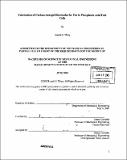Fabrication of carbon-aerogel electrodes for use in phosphoric acid fuel cells
Author(s)
Tharp, Ronald S
DownloadFull printable version (2.438Mb)
Other Contributors
Massachusetts Institute of Technology. Dept. of Mechanical Engineering.
Advisor
Ernest Cravalho.
Terms of use
Metadata
Show full item recordAbstract
An experiment was done to determine the ability to fabricate carbon aerogel electrodes for use in a phosphoric acid fuel cell (PAFC). It was found that the use of a 25% solution of the surfactant Cetyltrimethylammonium chloride (CTAC) in water resulted in the creation of micelle within the pores of the organic aerogel. The micelle allowed the aerogel to be air dried while maintaining the desired pore composition. Further testing also showed that the resulting carbon aerogels had a specific ionic conductivity greater than that of a commercial porous carbon electrode Work was done to explore the use of the DRIE method to create a silicone die for the fabrication of a carbon aerogel electrode. It was found that a die could be created but had to undergo 0₂ plasma treatment in order to improve the wetting properties of the die. The resulting electrode was found to be very brittle at a thickness of 200 [mu]m or less, but responded well to being electroplated with platinum through the use of a platinum salt and a non-ionic surfactant gel.
Description
Thesis (S.B.)--Massachusetts Institute of Technology, Dept. of Mechanical Engineering, 2005. Includes bibliographical references (leaf 47).
Date issued
2005Department
Massachusetts Institute of Technology. Department of Mechanical EngineeringPublisher
Massachusetts Institute of Technology
Keywords
Mechanical Engineering.